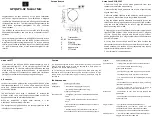
Device description
Leuze electronic
DDLS 508
11
3.1.2 Performance characteristics and delivery options
• Protocol-independent data transmission of all TCP/IP and UDP protocols, e.g.
• EtherCat (with restrictions on functions “Link Fault Pass Through” and “Distributed Clock”)
• PROFINET RT
• EthernetIP (Rockwell)
• … and more
• Data transmission over a range of up to 120 m
• Optional alignment laser including spirit level for mounting support
• Planar surfaces on top and side for supporting a level or alignment straightedge
• Single-handed adjustment (SHA) for aligning the devices by one person
• Optional variants with integrated heating for operating temperatures below -5 °C
Use to
-
35 °C
• Transmission optics with larger beam spread on request
3.1.3 Accessories
For exact details and order information, see chapter 11 "Ordering information and accessories".
• Adapter plate for installing instead of a DDLS 200
• Ready-made cable for M12 connections
• Customizable connector plug
3.1.4 Operating principle
Two identical devices are used to establish a data transmission path.
• Both devices with frequency F0
• Part designation: DDLS 5XX xxx.0 YY
• Designation on the name plate: Frequency F0
Figure 3.2: Name plate
The PROFINET IRT protocol is a special case. The DDLS 508 cannot satisfy the specifications
of the transmission criteria for PROFINET IRT.
For details on the delay times or the jitter-relevant device data, see chapter 4.8 "Cascading (se
ries connection) of multiple data transmission systems".
NOTICE
Selecting transmission frequency F1 or F2!
For a given transmission path, the devices must be set to different transmission frequencies during
commissioning.
Transmission frequency F1 or F2 is configured with the operating mode selector switch [Mode] via the
FRE LED (see chapter 6.1 "Setting the operating mode").
The transmission path is correctly configured if the FRE LED on one device illuminates and does not
illuminate on the opposing device.











































